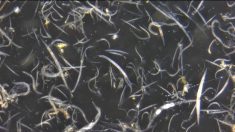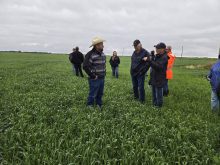Provincial Summary:
- Seeding progress in Manitoba is estimated to be 98 per cent complete. Some reseeding is still occurring.
- Generally, the condition of most crop types is rated as good.
- Heavy rains in some areas of Manitoba have resulted in ponding and saturated soil conditions, mainly in the lower and poorly drained areas of the fields.
- Warmer temperatures over the past week allowed producers to make good progress on weed control operations.
- Fungicide applications in winter wheat for leaf disease control and suppression of fusarium head blight continue.
- First cut of Manitoba’s hay crop has started in Central and Interlake Regions; it is anticipated haying activity will start in the remaining regions in the coming week. 
Read Also

Critical growing season is ahead for soybeans
What the weather turns out to be in the United States is going to have a significant impact on Canadian producers’ prices
Southwest Region
Several thunderstorms across the Southwest Region resulted in variable precipitation with amounts ranging from 25 to 100 mm; the higher amounts were reported near the Saskatchewan border. Some producers had to reseed canola acres because of flea beetle damage.
Cutworm damage in some areas has also resulted in some reseeding. Several fields are showing areas with poor germination due to salinity; the number of acres impacted is higher when compared to previous years.
Several producers started applying fungicides to winter wheat as disease pressure increases. There are reports of tan spot and septoria from several areas, as well as powdery mildew. The winter wheat crop continues to have significant growth.
Pastures and hay land are progressing well with most cattle moved to pasture. Producers wanting to put up high-quality feed will be monitoring their fields as first cut is close to being ready.
Dugouts in the Southwest are 80 per cent to 100 per cent full after the recent rainfall.
Northwest Region
The Northwest Region received rainfall for most of the weekend with amounts ranging from 10 mm to over 100 mm. The highest rainfall was recorded in the Swan Valley and Roblin areas.
Crops throughout the Northwest Region are advancing quite well.
Crop yellowing is evident on some fields where water is ponding and adjacent soils are saturated. There will be some urgency to getting some fields sprayed for weeds before the crop and weeds advance too far. Approximately 10,000 acres in the Roblin area were treated for flea beetles over the past week. There were no reports of diamondback larva activity in the region.
Hay crops are in very good condition and pastures are doing well.
Dugout and on-farm water supplies are adequate. 

Central Region
All areas in the Central Region received rainfall; accumulations range from 25 to 50 mm. The Starbuck area also received more rain and is very wet in most of that district. Water ponding is evident in most places and crops are showing signs of moisture stress.
Winter wheat has headed out in all areas with spraying for fusarium head blight continuing. Most cereal crops range from the tillering to the stem elongation stage. Monitoring continues for leaf diseases. There are some reports of bacterial blight in oats. Wheat streak mosaic and barley yellow dwarf continue to be observed. Some tan spot and powdery mildew is evident below the canopy.
All of the reseeded canola has emerged and is looking good. Corn development ranges from the three-leaf to six-leaf stage and has recovered well in areas that were impacted by frost. Edible beans are in the unifoliate to first trifoliate stage. Spraying in edible beans will start this week.
The quality of first-cut alfalfa/grass hay crop is good with expected first-cut yield ranging from 1.25 to 1.5 tonnes/acre. The hay crop appears to be average this year with moderate to slow growth.
Livestock water is adequate throughout the Central Region.
Eastern Region
Warm, sunny and generally good growing conditions predominated in the Eastern Region through the week. Over the weekend, rainfall occurred with accumulations ranging from 12 to 75 mm.
Winter wheat and fall rye crops are either heading or flowering. Fungicide applications for either flag leaf protection from leaf diseases or fusarium head blight are occurring.
In general, the condition of annual crops is rated as good. Across the region, 60 per cent of herbicide applications are completed.
In areas where injury from the May 30 frost event was the most severe, there were delays with herbicide applications as to allow for crop recovery. Flea beetles in canola continue to be a concern, although it is diminishing. Cutworms in sunflower, corn and canola are still being detected with some spraying occurring.
The majority of hay and pasture land is rated as fair. Topsoil moisture levels are rated as adequate with drier areas still present in southern areas.
Interlake Region
Heavy rains on the weekend will cause crop damage in areas near Gimli, Petersfield and Teulon. Winter wheat is at flag leaf to heading with some fungicide application complete.
Forage restoration activity is general with some seeding and tillage taking place. First-cut haying started early in the week. Hay crops have progressed well with newer stands in excellent condition while old stands are showing slow growth. Leafcutter bee incubation has started. Most producers report adequate pasture production. There are scattered reports of water supply shortfalls as dugouts are generally below average for water levels.


















